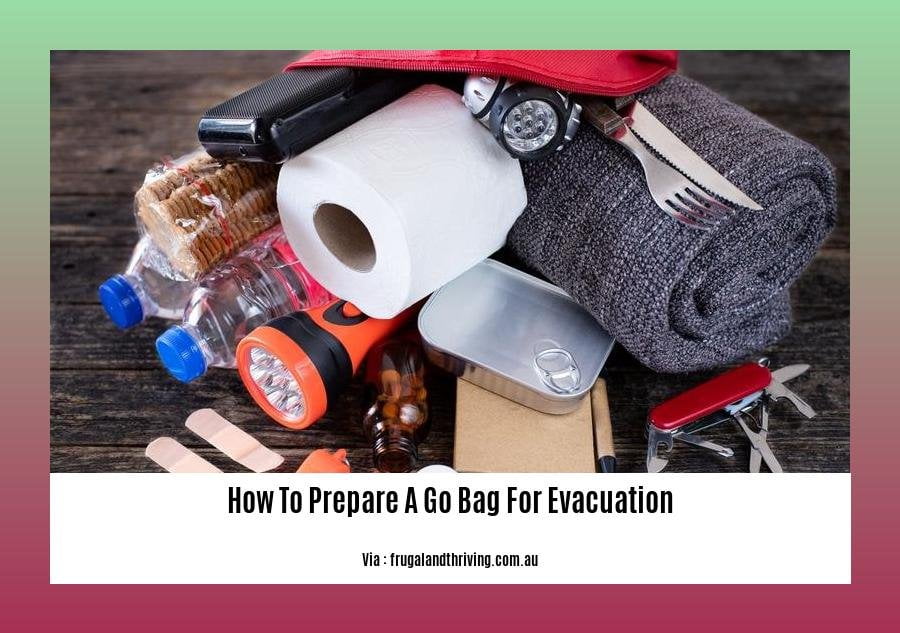Prepare for the worst and hope for the best with “How to Prepare a Go-Bag for Evacuation: The Ultimate Guide to Staying Safe.” Learn the essential items to pack, including food, water, first-aid supplies, and more. Download our free emergency go-bag checklist PDF, and ensure you and your loved ones are ready for any evacuation.
Key Takeaways:

- Include 1 gallon of water per person, per day for a 3-day supply.
- Pack non-perishable food, a first aid kit, flashlight, batteries, and a whistle.
- Carry a multi-tool, cash, and important documents in a waterproof bag.
- Select a durable bag with enough space for essentials.
- Consider backpacks, duffel bags, or suitcases with wheels.
- Keep the go-bag easily accessible.
- Plan evacuation routes and identify designated meeting places.
- Scan and save important documents, and make an evacuation action list.
How to Prepare a Go-Bag for Evacuation
In times of crisis, a well-prepared go-bag can be your lifeline. Here’s a comprehensive guide to help you create one for your family:
Contents:
- Water: 1 gallon per person, per day (3-day supply)
- Non-perishable food: High-energy snacks, canned goods
- First aid kit: Antiseptic wipes, bandages, pain relievers
- Flashlight: With extra batteries
- Whistle: To signal for help
- Multi-tool: With scissors, pliers, knife
- Cash: In case of power outages
- Important documents: Passports, insurance cards (in a waterproof bag)
Selecting the Bag:
Choose a sturdy bag that can withstand the elements and hold all your essentials comfortably. Consider backpacks, duffel bags, or suitcases with wheels.
Evacuation Planning:
- Keep your go-bag easily accessible.
- Identify evacuation routes and designated meeting places.
- Scan and save important documents digitally.
- Create an action list for evacuation (e.g., turning off utilities, locking doors).
Remember: A go-bag is a life-saving tool. Take the time to assemble one today and ensure your family’s safety during an evacuation.
For different emergencies, essential go-bag contents are different, so check out our recommendations for what to pack. Also, for a portable emergency kit, this article Creating a Portable Emergency Kit has a good list. Also, in case of an emergency, having key documents is useful, so to create a grab-and-go binder with those documents is helpful.
Emergency Kit Supply List
Key Takeaways:
- Water: 1 gallon per person, per day
- Food: Non-perishable items, such as canned goods, energy bars, and trail mix
- First aid kit: Antiseptic wipes, bandages, pain relievers, antiseptic cream
- Flashlight: LED flashlight with extra batteries
- Whistle: For signaling, should be loud and high-pitched
- Multi-tool: Knife, pliers, screwdriver, can opener
- Cash: Small bills and change
- Important documents: Passports, insurance cards, medical records (in waterproof bag)
Step 1: Choose a Durable Bag
Select a sturdy bag large enough to hold your essential items. Consider backpacks, duffel bags, or suitcases with wheels.
Step 2: Gather Essential Supplies
Refer to the Emergency Kit Supply List provided above and gather the necessary items. Remember to include specific items for each family member, such as medications or baby supplies.
Step 3: Organize and Pack
Pack items in a way that allows for easy access. Keep important items, such as first aid kits and flashlights, within reach. Consider using packing cubes or Ziploc bags to organize smaller items.
Step 4: Keep Your Go-Bag Accessible
Store your go-bag in a quickly accessible location, such as near the front door or in your vehicle’s trunk.
Most Relevant URL Source:
- AARP Emergency Survival Kit
- [Citation:** AARP. “Emergency Survival Kit | Here’s A List of Essentials”. Accessed [date].]
Go Bag List
Key Takeaways:
- Gather essential supplies for 3 days, focusing on water, food, and shelter.
- Include a first aid kit, fire starter, and whistle for emergencies.
- Pack items for self-defense, warmth, navigation, and communication.
- Consider tools, hygiene items, and valuables for added comfort and security.
Navigating an evacuation can be daunting. But with a well-prepared Go Bag List, you can ensure your safety and well-being during unforeseen circumstances. Here’s how to assemble a comprehensive go-bag for evacuation:
Step 1: Choose a Durable Go Bag
Opt for a bag made of water-resistant fabric with comfortable straps and a hip belt for stability.
Step 2: Gather Critical Supplies
Adhere to the “Rule of 3’s”: pack at least 1 gallon of water, non-perishable food, and a form of shelter for each person for 3 days. Don’t forget a first aid kit, fire starter, and a loud whistle.
Step 3: Pack Additional Essential Items
Consider items for self-defense, such as a personal alarm or pepper spray. Include fire and heat sources like matches or a lighter. Navigation tools like a map and compass are crucial. Don’t forget communication devices, such as a cellphone and portable charger. Pack versatile tools, including a multi-tool, knife, and flashlight. Hygiene items and a change of clothing are essential for comfort. Secure important documents and valuables in waterproof bags.
Citation:
NPR: How to make your own emergency go bag











